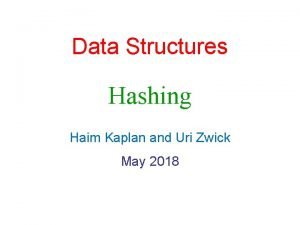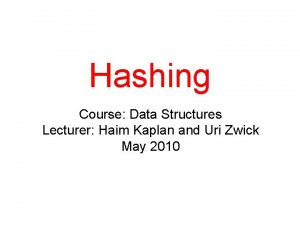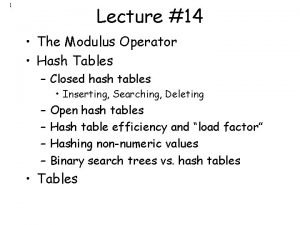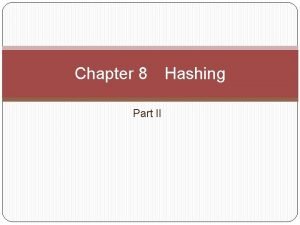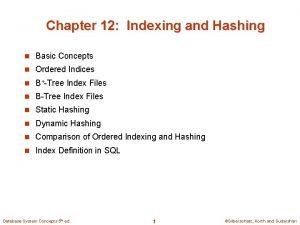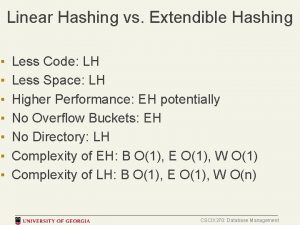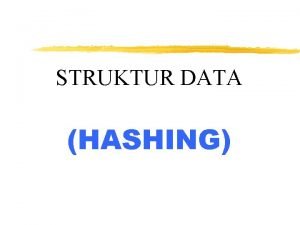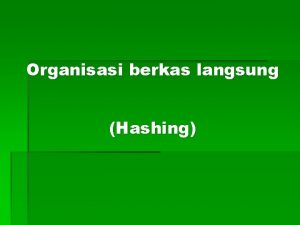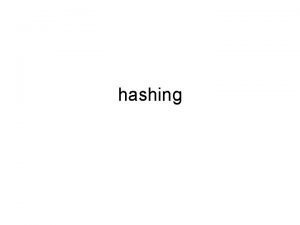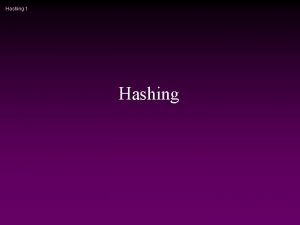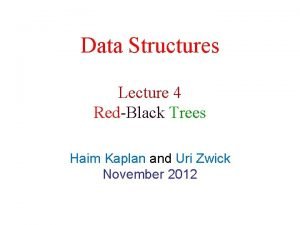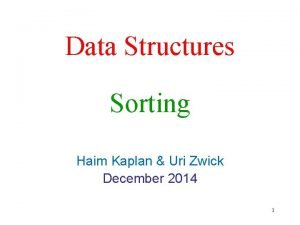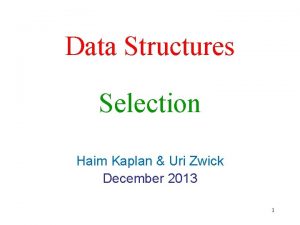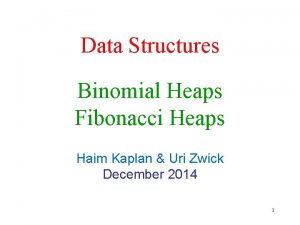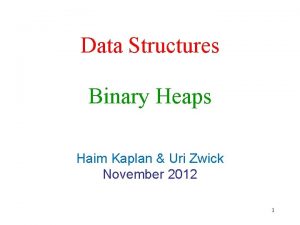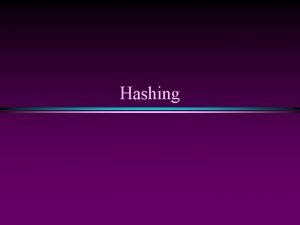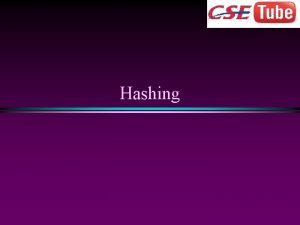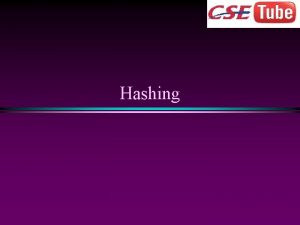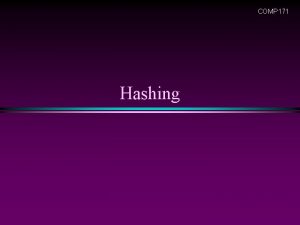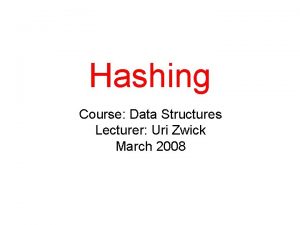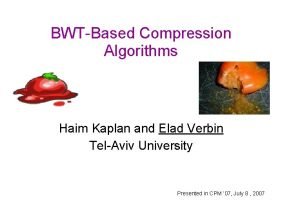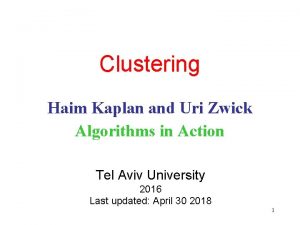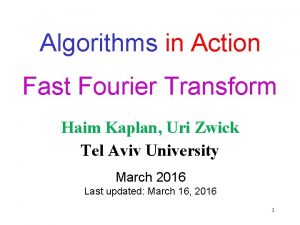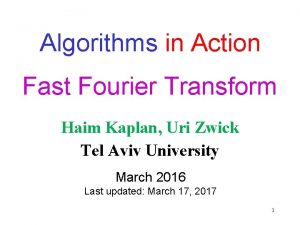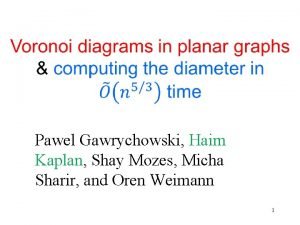Hashing Course Data Structures Lecturer Haim Kaplan and

























![Two level hashing [Fredman, Komlós, Szemerédi (1984)] Two level hashing [Fredman, Komlós, Szemerédi (1984)]](https://slidetodoc.com/presentation_image/2a60bc8a655a9d26133f6d6882a30409/image-26.jpg)
![Two level hashing [Fredman, Komlós, Szemerédi (1984)] Two level hashing [Fredman, Komlós, Szemerédi (1984)]](https://slidetodoc.com/presentation_image/2a60bc8a655a9d26133f6d6882a30409/image-27.jpg)
![Two level hashing [Fredman, Komlós, Szemerédi (1984)] Assume that each hi can be represented Two level hashing [Fredman, Komlós, Szemerédi (1984)] Assume that each hi can be represented](https://slidetodoc.com/presentation_image/2a60bc8a655a9d26133f6d6882a30409/image-28.jpg)

- Slides: 29

Hashing Course: Data Structures Lecturer: Haim Kaplan and Uri Zwick May 2010

Dictionaries D Dictionary() – Create an empty dictionary Insert(D, x) – Insert item x into D Find(D, k) – Find an item with key k in D Delete(D, k) – Delete item with key k from D (Predecessors and successors, etc. , not required) Can use balanced search trees O(log n) time per operation Can we do better? YES !!! 2

Dictionaries with “small keys” Suppose all keys are in {0, 1, …, m− 1}, where m=O(n) Can implement a dictionary using an array D of length m. 01 m-1 Special case: Sets D is a bit vector O(1) time per operation (after initialization) (Assume different items have different keys. ) What if m>>n ? Use a hash function 3

Huge universe U Hashing Hash function h 01 Collisions m-1 Hash table

Hashing with chaining Each cell points to a linked list of items 01 i m-1

What makes a hash function good? Should behave like a “random function” Should have a succinct representation Should be easy to compute Usually interested in families of hash functions Allows rehashing, resizing, …

Simple hash functions The modular method The multiplicative method

Tabulation based hash functions “byte” … … + Can be used to hash strings hi can be stored in a small table

Universal families of hash functions A family H of hash functions from U to [m] is said to be universal if and only if

A simple universal family To represent a function from the family we only need two numbers, a and b. The size m of the hash table is arbitrary.

Probabilistic analysis of chaining n – number of elements in dictionary D m – size of hash table =n/m – load factor Assume that h is randomly chosen from a universal family H Expected Successful Search Delete Unsuccessful Search (Verified) Insert Worst-case

Chaining: pros and cons Pros: Simple to implement (and analyze) Constant time per operation (O(n/m)) Fairly insensitive to table size Simple hash functions suffice Cons: Space wasted on pointers Dynamic allocations required Many cache misses

Hashing with open addressing Hashing without pointers Insert key k in the first free position among Assumed to be a permutation No room found Table is full To search, follow the same order

Hashing with open addressing

How do we delete elements? Caution: When we delete elements, do not set the corresponding cells to null! “deleted” Problematic solution…

Probabilistic analysis of open addressing n – number of elements in dictionary D m – size of hash table =n/m – load factor (Note: 1) Uniform probing: Assume that for every k, h(k, 0), …, h(k, m-1) is random permutation Expected time for unsuccessful search Expected time for successful search

Probabilistic analysis of open addressing Claim: Expected no. of probes for an unsuccessful search is at most: If we probe a random cell in the table, the probability that it is full is . The probability that the first i cells probed are all occupied is at most i.

Open addressing variants How do we define h(k, i) ? Linear probing: Quadratic probing: Double hashing:

Linear probing “The most important hashing technique” More probes than uniform probing, as probe sequences “merge” But, much less cache misses More complicated analysis (Universal hash families, as defined, do not suffice. )

Linear probing – Deletions Can the key in cell j be moved to cell i?

Expected number of probes Unsuccessful Search Successful Search Uniform Probing Linear Probing When, say, 0. 6, all small constants

Expected number of probes

Perfect hashing Suppose that D is static. We want to implement Find is O(1) worst case time. Perfect hashing: No collisions Can we achieve it?

Expected no. of collisions

Expected no. of collisions If we are willing to use m=n 2, then any universal family contains a perfect hash function. No collisions!
![Two level hashing Fredman Komlós Szemerédi 1984 Two level hashing [Fredman, Komlós, Szemerédi (1984)]](https://slidetodoc.com/presentation_image/2a60bc8a655a9d26133f6d6882a30409/image-26.jpg)
Two level hashing [Fredman, Komlós, Szemerédi (1984)]
![Two level hashing Fredman Komlós Szemerédi 1984 Two level hashing [Fredman, Komlós, Szemerédi (1984)]](https://slidetodoc.com/presentation_image/2a60bc8a655a9d26133f6d6882a30409/image-27.jpg)
Two level hashing [Fredman, Komlós, Szemerédi (1984)]
![Two level hashing Fredman Komlós Szemerédi 1984 Assume that each hi can be represented Two level hashing [Fredman, Komlós, Szemerédi (1984)] Assume that each hi can be represented](https://slidetodoc.com/presentation_image/2a60bc8a655a9d26133f6d6882a30409/image-28.jpg)
Two level hashing [Fredman, Komlós, Szemerédi (1984)] Assume that each hi can be represented using 2 words Total size:

A randomized algorithm for constructing a perfect two level hash table: Choose a random h from H(n) and compute the number of collisions. If there are more than n collisions, repeat. For each cell i, if ni>1, choose a random hash function from H(ni 2). If there any collisions, repeat. Expected construction time – O(n) Worst case search time – O(1)
 Haim kaplan
Haim kaplan Haim kaplan
Haim kaplan Haim kaplan
Haim kaplan Lecturer's name or lecturer name
Lecturer's name or lecturer name What does a modulo operator do
What does a modulo operator do Hashing
Hashing Static hashing and dynamic hashing
Static hashing and dynamic hashing Linear hashing
Linear hashing Haim g ginott
Haim g ginott Haim ginott congruent communication
Haim ginott congruent communication Kaplan acca course fee
Kaplan acca course fee Jeannie watkins
Jeannie watkins Spe distinguished lecturer
Spe distinguished lecturer Hello teacher good afternoon
Hello teacher good afternoon Photography lecturer
Photography lecturer Lecturer in charge
Lecturer in charge Designation lecturer
Designation lecturer Designation of lecturer
Designation of lecturer Gcwak
Gcwak Lecturer name
Lecturer name Pearson lecturer resources
Pearson lecturer resources 140000/120
140000/120 Lector vs lecturer
Lector vs lecturer Lecturer in charge
Lecturer in charge Cfa lecturer handbook
Cfa lecturer handbook Lecturer asad ali
Lecturer asad ali Function of homologous structure
Function of homologous structure Fungsi hash yang menggunakan metode penjumlahan adalah
Fungsi hash yang menggunakan metode penjumlahan adalah Pengertian organisasi berkas langsung
Pengertian organisasi berkas langsung Mid-square hashing
Mid-square hashing
